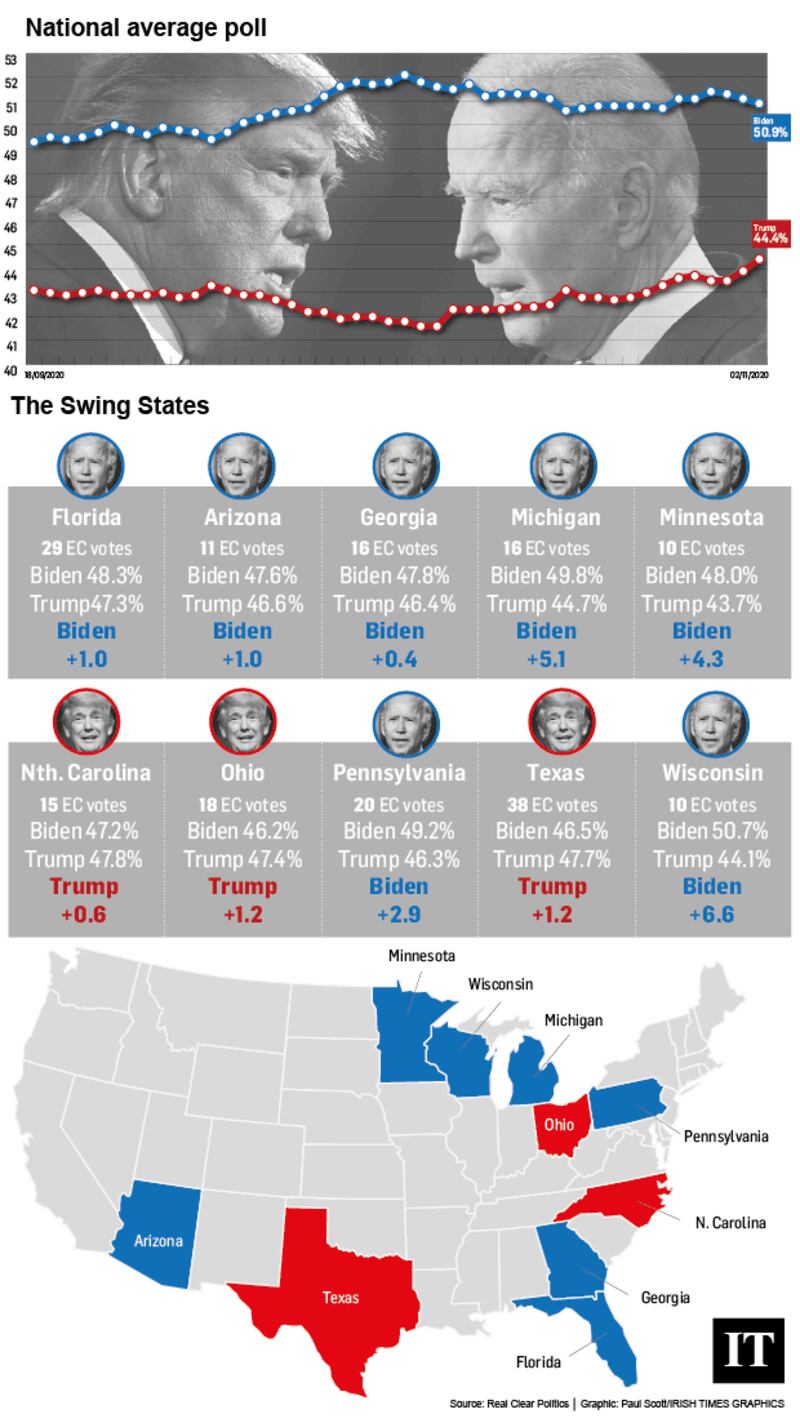Polls close on Tuesday evening and counting will begin in one of the most closely watched US elections. While a final result may not be known for days – or potentially weeks, given that Donald Trump has threatened to legally challenge the result – there may be some results from early states that will indicate how the election will play out.
As it happens, a clutch of important states – Florida, North Carolina, Arizona and Georgia – will be announced relatively early . Florida in particular is crucial. If Joe Biden wins there and combines it with any of the other three, Trump's quest for a second term is all but over. It is highly unlikely that he will pick up sufficient votes elsewhere to reach the target of 270 electoral college votes.
But if Trump wins Florida – and the polls there are extremely tight – we will be in for a long night and it could potentially drag on for weeks.

[ comprehensive analysis of the key swing statesOpens in new window ]

Key times
Midnight (all times Irish): Georgia is the stand-out state when the first polls close at 7pm eastern time (midnight in Ireland). Trump won the state's 16 electoral votes by 5 percentage points in 2016, but Democrats see an opening, confident that increased voter participation in the Atlanta area could benefit them. Because counties were allowed to start processing absentee ballots once they were received, there should be an early result from the state. Two Senate races are also in play here, though both contests could go to run-offs if no candidate passes the 50 per cent threshold.
Wednesday 12.30am: North Carolina polls close. This state is a toss-up, but it is usually one of the first to declare a result. Early-voting ballots will be reported first, followed by votes cast on election day. The supreme court has allowed absentee ballots to be counted for up to nine days after the election, which suggests that a definitive result could be days away. However, North Carolina is permitted to sort postal ballots before election day, so this will speed up the process.
Polls also close now in the key midwestern state of Ohio, and officials will begin announcing the results of absentee ballots they received half an hour later. The results from election day polling centres will then begin to trickle through. Though the state can continue to accept absentee ballots after election day, these may constitute a small portion of the total votes cast. Ohio has leaned increasingly Republican in recent years, but Democrats believe it may be in play. Biden scheduled a last-minute visit to the state on Monday.
1am: Things get interesting when polls close in Florida, perhaps the most important swing state in this election. With 29 electoral votes, Trump in particular needs to win this state if he has a chance of winning the electoral college. Because Florida allows for the processing of mail-in ballots before election day, it is possible that there could be an early result from the Sunshine State.
Also among the large number of states to close at this time is Pennsylvania, which promises to be one of the most closely-watched of the election, but a final result may take days or even weeks. Pennsylvania significantly expanded its absentee voting options in this election cycle, but the supreme court ruled that the state can continue to accept postal votes until three days after the election, once they have been posted by November 3rd according to the postmark. Further, several counties have said they will not start counting mail-in ballots until the day after the election. Trump has spoken about Pennsylvania's voting system in particular, suggesting he could challenge the result.
2am: Though in the mountain time zone, Arizona's polls close at 7pm local time. It typically reports results early, as it has a long tradition of mail-in voting. Democrats are hoping to flip this Republican-leaning state, boosted by demographic changes in Maricopa County around Phoenix – the fourth most populous county in the country. Democrats are confident of winning a Senate seat too, with astronaut Mark Kelly, husband of former congresswoman Gabby Giffords, leading Republican incumbent Martha McSally in polls.
Michigan polls also close now. The midwestern state – one of the trio of rust-belt states that flipped from Democrat to Republican in 2016 – is a crucial battleground. Trump won here by just 10,700 votes in 2016. But the governor has tried to manage expectations about when a result will be known. While the state allows minimal early ballot processing, officials have said that a final tally may not be known until Friday.
Wisconsin will also close its polls. Although the state will not start counting absentee votes until Wednesday, it will count all other votes through the night, and the governor has indicated that a result could be known on election night or on Wednesday.
Colorado's polls close now too and it typically reports results early, given the high numbers voting by mail. The Senate race here is one to watch, with Republican Cory Gardner facing a challenge from former governor John Hickenlooper.
Texas is the other one to keep an eye on at this time. With 38 electoral college votes, the state will be under scrutiny given the record number of people who voted early. Though typically it leans Republican, Democrats are hoping that demographic changes could help flip the state blue. Given the sheer size of the state, the vote-counting process could take some time, though most absentee votes will begin to be counted on Tuesday.
3am: Nevada closes its polls. The state was won by Hillary Clinton by just two percentage points and there have been signs that Latino voters are less supportive of Biden. For the first time, Nevada has mailed absentee ballots to all registered voters – prompting legal challenges from Republicans. The result is that there will be more absentee ballots to count than usual.
4am: California polls close at 11pm eastern time. The most populous state in the country, California has become reliably Democrat in recent years. It has a long tradition of mail-in voting, and final tallies can take weeks in the state. Late-arriving ballots, which can be accepted weeks after election day, usually favour Democrats.
How we will cover the story
With all eyes on the United States and the outcome of one of the most hotly contested elections in decades, The Irish Times is providing comprehensive live coverage throughout Tuesday night, Wednesday morning and as the aftermath comes into focus in the coming days.
Our team of correspondents and writers, led by Washington Correspondent Suzanne Lynch, will be on hand to provide the best reporting and analysis as results emerge.
We will be providing push notifications on key developments overnight.
Patrick Freyne, Simon Carswell, Hugh Linehan and Sarah Burns will keep you updated with every twist and turn on our special overnight US election live blog, starting on Tuesday afternoon and running through the night and Wednesday.
Presidential and Congressional results data will be published as we get it here. If you can't stay with the coverage during the night, log on to The Irish Times first thing on Wednesday morning where Suzanne Lynch's analysis of the unfolding result will be available.
She will also be our special guest on the Inside Politics podcast, available on Wednesday morning - go here - (or wherever you get your podcasts) to follow the podcast now.
Throughout Wednesday, our writers including Fintan O'Toole, Political Editor Pat Leahy, Europe Correspondent Naomi O'Leary and Stephen Starr, reporting from Ohio, will pore over the results with analysis and the view from the ground.
On Thursday we will publish a bumper edition of The Irish Times print edition and our coverage continues with a special edition of the World View podcast later on Thursday.

You can follow the World View podcast here or wherever you get your podcasts.
In the meantime, don't forget to sign up for Suzanne Lynch's US Election Diary, which has been running throughout the campaign and will continue this week (previous diaries can be found here) or one of our other email news digests to stay up-to-date.
If you need some extra help in deciding how to follow the results, check out our piece on the best television and online coverage of the election result.
All of our US election coverage is available in one place here.
And of course,you can subscribe for unfettered access to every piece of journalism The Irish Times produces, across our websites, mobile app, ePaper and specially produced subscriber-only articles and email digests.
How does voting work?
As the United States goes to the polls the country’s unique electoral system will once again be on display.
Unlike in most modern democracies, the candidate who wins the most votes does not necessarily win the election. Instead, each of the states is ascribed a certain number of “electoral college votes”.
Candidates must win at least 270 of the total 538 electoral votes available. In a further quirk, the founding fathers of the republic in the late 18th-century decided that electors – and not the American people – would officially cast their ballots for president. These state representatives transmit the result from their state to several institutions in Washington, a process which will occur on December 14th this year.
Within the electoral college system, California has the highest number with 55 votes, while sparsely-populated states like Wyoming and Alaska have the minimum number of three.
As a result, there is little point in candidates campaigning in partisan states – New York is always going to vote Democrat, for example, while Kentucky can be counted on to choose a Republican candidate.

Instead, the focus is on states that traditionally swing between Democrat and Republican and have historically reported tight margins, or states that are changing demographically. An example this year is Texas, where Democrats are hoping that an influx of new voters to suburban areas around the state’s big cities may push the state into the Democratic lane.
States with a high number of electoral college votes – Florida with 29, Pennsylvania with 20 – are obviously more valuable, and traditionally attract significant investment from candidates.
Most states operate a winner-takes-all system – ie, if a candidate wins more than 50 per cent of the vote, he or she is awarded all the electoral college votes for that state.
Trump’s electoral trick last time around was to win a trio of states in the midwest known as the “rust belt” – Michigan, Wisconsin and Pennsylvania – which Democrats had hoped to win. The margins were tight, but it didn’t matter. He scooped up their 46 electoral college votes, and in the end won the election with a healthy 304 electoral college votes compared to Hillary Clinton’s 227.
This year, as in other years, the candidates are working out possible “paths” to victory – states that will help them reach the 270 threshold.
In the vast majority of cases, the candidate who wins the popular vote also wins the electoral college system, but notable exceptions include the 2000 race, which came down to a few hundred disputed votes in Florida, and 2016.
Hillary Clinton won 65.8 million votes, while Donald Trump won 62.9 million, with the result that she won the popular vote by 2.9 million votes – the largest vote margin of any losing presidential candidate in American history.
Four years later it is quite possible that Joe Biden could win the popular vote by an even bigger margin – for example, by racking up huge numbers in coastal states – but still lose the electoral college.



















